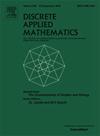监控图形中的边测地集
IF 1
3区 数学
Q3 MATHEMATICS, APPLIED
引用次数: 0
摘要
我们在网络监控领域引入了一个新的图论概念。在这个领域,人们希望监控网络的顶点和/或边缘(作为一个图),以检测和防止故障。灵感来自两个概念研究文献(edge-geodetic集和distance-edge-monitoring集),我们定义一组监控edge-geodetic的概念(简称MEG-set)的一个图G作为edge-geodetic集合S⊆V (G)的G (G的,每条边躺在两个顶点之间的最短路径(S)的附加属性,每条边e G的,有一对顶点x, y的年代,e位于x和y之间的所有最短路径。动机是,如果某些边e从网络中移除(例如,如果它停止工作),监视探针x和y将检测到故障,因为它们之间的距离将增加。我们通过推导一些基本图类(树、环、单环图、完全图、网格、超立方体、电晕积等)的meg集的最小大小,探索了meg集的概念,并利用图的反馈边集证明了meg集的上界。我们还证明了确定图的meg集的最小大小是np困难的,即使对于最大度最多为9的图也是如此。本文章由计算机程序翻译,如有差异,请以英文原文为准。
Monitoring edge-geodetic sets in graphs
We introduce a new graph-theoretic concept in the area of network monitoring. In this area, one wishes to monitor the vertices and/or the edges of a network (viewed as a graph) in order to detect and prevent failures. Inspired by two notions studied in the literature (edge-geodetic sets and distance-edge-monitoring sets), we define the notion of a monitoring edge-geodetic set (MEG-set for short) of a graph as an edge-geodetic set of (that is, every edge of lies on some shortest path between two vertices of ) with the additional property that for every edge of , there is a vertex pair of such that lies on all shortest paths between and . The motivation is that, if some edge is removed from the network (for example if it ceases to function), the monitoring probes and will detect the failure since the distance between them will increase.
We explore the notion of MEG-sets by deriving the minimum size of a MEG-set for some basic graph classes (trees, cycles, unicyclic graphs, complete graphs, grids, hypercubes, corona products...) and we prove an upper bound using the feedback edge set of the graph.
We also show that determining the smallest size of an MEG-set of a graph is NP-hard, even for graphs of maximum degree at most 9.
求助全文
通过发布文献求助,成功后即可免费获取论文全文。
去求助
来源期刊

Discrete Applied Mathematics
数学-应用数学
CiteScore
2.30
自引率
9.10%
发文量
422
审稿时长
4.5 months
期刊介绍:
The aim of Discrete Applied Mathematics is to bring together research papers in different areas of algorithmic and applicable discrete mathematics as well as applications of combinatorial mathematics to informatics and various areas of science and technology. Contributions presented to the journal can be research papers, short notes, surveys, and possibly research problems. The "Communications" section will be devoted to the fastest possible publication of recent research results that are checked and recommended for publication by a member of the Editorial Board. The journal will also publish a limited number of book announcements as well as proceedings of conferences. These proceedings will be fully refereed and adhere to the normal standards of the journal.
Potential authors are advised to view the journal and the open calls-for-papers of special issues before submitting their manuscripts. Only high-quality, original work that is within the scope of the journal or the targeted special issue will be considered.
 求助内容:
求助内容: 应助结果提醒方式:
应助结果提醒方式:


